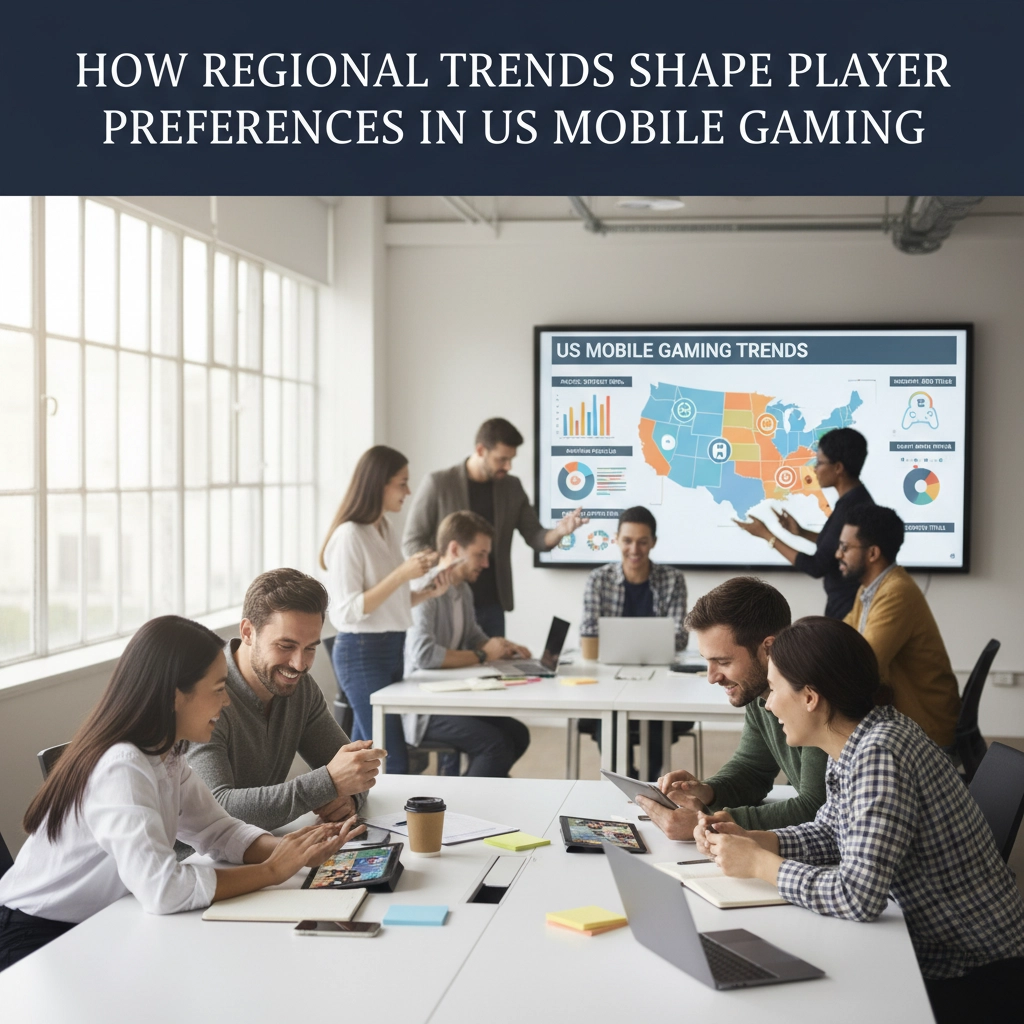How Regional Trends Shape Player Preferences in US Mobile Gaming

The US mobile gaming market isn't just one massive, homogeneous audience waiting to download your next hit game. It's a complex ecosystem where regional trends, demographic shifts, and cultural nuances create distinct player preferences that can make or break your market entry strategy. For international studios eyeing American success, understanding these regional dynamics isn't optional: it's essential.
The Reality of America's Mobile Gaming Landscape
Let's start with the facts that might surprise you. The US mobile gaming market has reached what industry experts call "saturation maturity." While emerging markets like Latin America and the Middle East are seeing explosive growth, the US experienced a 5% decline in mobile game downloads year-over-year. But here's the twist: this isn't bad news.
Despite fewer new downloads, time spent in games actually rose 8% globally, with US players leading this engagement surge. Revenue per user is climbing, especially on iOS, where American players are proving they'll pay for quality experiences. This means the US market has evolved from a numbers game to a quality game.
The economics tell the story. User acquisition costs in North America range from $2-$5, compared to just $0.50-$2 in Latin America. Those higher costs reflect something crucial: American players are valuable, engaged, and willing to spend: but they're also harder to attract and retain.

Demographic Shifts Reshaping Regional Preferences
The stereotype of mobile gamers as young males died years ago, but many international studios are still building games for that outdated persona. Today's US mobile gaming audience spans every demographic you can imagine, and these groups have distinct regional clustering patterns that smart studios are learning to navigate.
The Senior Gaming Surge is happening primarily in suburban and retirement-heavy regions like Florida, Arizona, and parts of California. These players aren't just dabbling in Candy Crush: they're driving significant revenue in puzzle games, card games, and surprisingly, strategy games. They value cognitive challenge, social connection, and games that respect their time and intelligence.
Professional Stress-Relief Gaming dominates in major metropolitan areas like New York, San Francisco, and Chicago. These players use mobile games as brief escapes during commutes, lunch breaks, and wind-down periods. They prefer games with quick session lengths but deep progression systems they can return to consistently.
Family Gaming Hubs in suburban areas across the Midwest and South are creating demand for games that multiple generations can enjoy together. These regions drive adoption of cooperative mobile experiences and games with strong social features that connect family members across distances.
The Gen Z Gaming Revolution
Gen Z players are redefining what mobile gaming means, and their preferences are spreading outward from major urban centers to influence gaming trends nationwide. These players don't just want games: they want experiences that blend entertainment with social interaction, cultural relevance, and personal expression.
This generation favors games offering quick sessions but deep social interactions. They're not interested in time-wasting casual games or complex hardcore experiences that require hours of commitment. Instead, they want snackable gameplay that creates lasting social connections and provides material for social media sharing.
The regional impact is significant. Cities with major universities and young professional populations: think Austin, Portland, Denver, and Nashville: are becoming testing grounds for social mobile gaming innovations. Success in these markets often predicts broader national adoption patterns.

Monetization Patterns Across American Regions
Understanding how different regions approach spending in mobile games can transform your monetization strategy. Global mobile gaming revenue reached $92 billion in 2024, with American players contributing disproportionately through sophisticated spending patterns that vary significantly by region.
West Coast Spending tends toward premium experiences and cosmetic purchases. Players in California, Washington, and Oregon show higher willingness to pay for aesthetic customization, exclusive content, and convenience features. They're early adopters who view mobile game spending as lifestyle choices rather than necessity purchases.
East Coast Markets demonstrate more strategic spending behavior. Players in major northeastern cities analyze value propositions carefully and prefer spending on functional advantages, competitive edges, and time-saving features. They're willing to pay premium prices but expect premium value in return.
Southern and Midwest Regions show strong preference for community-driven spending. Players here are more likely to purchase items that enhance social gameplay, support favorite creators, or contribute to clan/guild progression. Group-oriented monetization strategies perform exceptionally well in these markets.
Cultural Nuances That International Studios Miss
American mobile gaming preferences aren't just about geography: they're about cultural values that manifest differently across regions. Individualism vs. Community Focus creates distinct gameplay preference patterns. West Coast players often prefer personal achievement and self-expression features, while Southern and Midwest players gravitate toward team-based progression and community challenges.
Time Perception Differences also play crucial roles. Urban areas with longer commutes create demand for games with meaningful 15-30 minute sessions. Rural and suburban areas with different lifestyle rhythms prefer games that accommodate irregular play patterns and don't penalize extended breaks.
Competitive vs. Cooperative Mindsets vary significantly. Major metropolitan areas often embrace competitive gaming elements, leaderboards, and PvP features. Smaller cities and rural areas show stronger preferences for cooperative gameplay and community building features.

Technology Adoption and Platform Preferences
Regional technology adoption patterns create distinct opportunities for international studios. iOS dominance in affluent suburban and urban areas means different monetization strategies compared to Android-heavy rural and lower-income regions.
The implications run deeper than device choice. iOS-dominant regions typically show higher spending per user, premium game adoption, and willingness to try new gaming concepts. Android-heavy regions often prefer proven gameplay mechanics, value-conscious purchasing, and games that work well on older devices.
5G rollout patterns are creating regional gaming capability gaps. Early 5G adoption areas are becoming testing grounds for cloud gaming, real-time multiplayer experiences, and bandwidth-intensive game features. Studios that understand these infrastructure differences can time their feature releases strategically.
Actionable Strategies for International Studios
Segment Your Launch Strategy based on regional preferences rather than treating the US as a single market. Consider soft-launching in specific regions that align with your game's core mechanics and monetization model. West Coast cities for innovation-focused games, East Coast markets for strategic games, and Southern regions for social-focused experiences.
Adapt Your User Acquisition to regional cost structures and player values. The $2-$5 acquisition costs in the US require precise targeting. Focus on high-value player segments in regions where your game type performs best rather than broad national campaigns.
Design Regional Content Strategies that acknowledge cultural preferences. Social features for community-focused regions, competitive elements for metropolitan areas, and family-friendly options for suburban markets. Your game doesn't need everything, but it needs the right things for your target regions.
Optimize Monetization by Region. West Coast players respond to premium aesthetics and convenience. East Coast players want functional value. Southern and Midwest players prefer community-oriented purchases. Tailor your in-game store and promotional strategies accordingly.

The Future of Regional Gaming Trends
The US mobile gaming landscape continues evolving as demographic shifts, technology adoption, and cultural changes create new regional preference patterns. Understanding these trends isn't about predicting the future: it's about building flexibility into your games and strategies.
Cross-generational gaming is becoming more important as families seek shared digital experiences. Professional integration continues growing as mobile games become accepted workplace stress relief tools. Cultural diversity in gaming preferences reflects America's changing demographics and requires inclusive design approaches.
For international studios, success in the US market depends on recognizing that "American players" don't exist: but specific regional player communities with distinct preferences, spending patterns, and engagement behaviors absolutely do. The studios that understand and respect these regional differences while building games that can adapt and evolve with changing preferences will find the American market not just accessible, but highly profitable.
The key isn't choosing one regional approach: it's building games flexible enough to serve multiple regional preferences while maintaining your core vision and strengths. That's how you turn regional trends from barriers into bridges to American gaming success.






